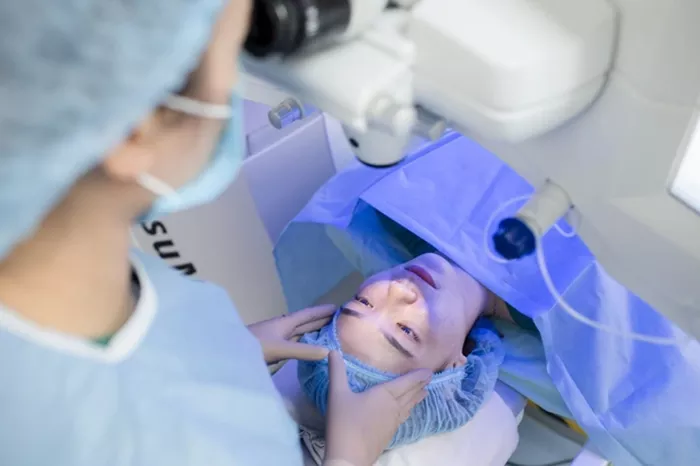LASIK (Laser-Assisted in Situ Keratomileusis) eye surgery devices are sophisticated tools used to correct refractive vision errors, including nearsightedness, farsightedness, and astigmatism. These devices employ precise laser technology to reshape the cornea, the eye’s transparent front surface, thus enhancing visual acuity. The main components of LASIK surgical instruments include:
Excimer Laser: Essential to LASIK procedures, the excimer laser emits a concentrated ultraviolet beam that meticulously reshapes the corneal curvature. This adjustment enables light to focus accurately on the retina, improving vision without the need for corrective lenses.
Microkeratome: This instrument creates a thin flap in the cornea, providing access to the inner layers for laser reshaping. The microkeratome is crucial for ensuring accuracy and consistency in flap creation.
Femtosecond Laser: A modern technology for flap creation, the femtosecond laser offers greater precision and reduces the risk of complications compared to traditional microkeratomes.
Market Drivers
Rising Prevalence of Refractive Errors: The increasing incidence of vision disorders such as myopia, hyperopia, and astigmatism is boosting the demand for effective, long-term corrective solutions. LASIK surgery is becoming a preferred option for those seeking enhanced vision.
Technological Advancements: Innovations in LASIK technology, including improvements in laser precision and new surgical instruments, are driving market growth. Enhanced safety features and better outcomes are encouraging more patients to opt for LASIK.
Increasing Awareness and Acceptance: Growing awareness of LASIK’s benefits and rising patient acceptance of refractive surgeries are expanding the market. Educational campaigns and success stories are fostering positive attitudes towards LASIK.
Demand for Minimally Invasive Procedures: The preference for minimally invasive surgical options is promoting the adoption of LASIK technology. Its non-invasive nature and quick recovery times make LASIK an attractive choice for vision correction.
Aging Population: As the geriatric population grows, so does the incidence of vision problems, increasing the demand for LASIK surgery and related devices.
Market Restraints
High Cost of LASIK Procedures: The expense of LASIK eye surgery and associated devices can be a barrier for some patients, limiting market growth. High costs and lack of insurance coverage in certain regions can affect patient affordability and access.
Risk of Complications: While generally safe, LASIK surgery carries risks such as dry eyes, glare, and halos. These potential complications may deter some individuals from undergoing the procedure.
Regulatory Challenges: Stringent regulatory requirements and approval processes for LASIK devices can pose challenges for manufacturers. Compliance with diverse regulations across regions can impact product development and market entry.
Opportunities for Market Players
Innovation in LASIK Technology: The continuous development of advanced LASIK devices presents opportunities for market players. Innovations such as wavefront-guided LASIK and femtosecond lasers can enhance surgical precision and patient outcomes.
Expanding Emerging Markets: Growing healthcare infrastructure and increasing disposable incomes in emerging markets offer significant growth opportunities for LASIK device manufacturers. Expansion into these regions can drive market growth and revenue.
Partnerships and Collaborations: Strategic alliances with healthcare providers, research institutions, and technology companies can offer valuable opportunities for innovation and market penetration. Such collaborations can enhance product offerings and accelerate growth.
Focus on Patient Education: Investing in patient education and awareness programs can boost LASIK adoption. Providing detailed information about LASIK’s benefits and risks can help build trust and encourage more individuals to consider the procedure.
Regional Insights
North America: Dominating the LASIK eye surgery devices market, North America benefits from high healthcare standards, advanced technology adoption, and substantial patient awareness. The U.S. and Canada are key contributors to this growth.
Europe: Europe is experiencing steady market growth, supported by technological advancements and increasing patient acceptance. Germany, the UK, and France are prominent players in the European market.
Asia-Pacific: The Asia-Pacific region is witnessing rapid growth in LASIK procedures due to rising healthcare investments and increasing demand for vision correction. China, India, and Japan are major markets in this region.
Latin America and Middle East & Africa: These regions are gradually expanding their LASIK infrastructure, with increasing awareness and access to advanced surgical technologies. Market growth is expected as healthcare facilities and patient access improve.
Competitive Landscape
The global LASIK eye surgery devices market is competitive, with several key players shaping the industry:
- Abbott Laboratories
- Johnson & Johnson Vision Care, Inc.
- Alcon Inc.
- Bausch + Lomb (a division of Bausch Health Companies Inc.)
- Zeiss International
- Nidek Co., Ltd.
- Lumenis Ltd.
- Synchrony Vision
These companies are focusing on technological innovation, strategic partnerships, and expanding their product portfolios to strengthen their market presence and drive growth.
Conclusion
The global LASIK eye surgery devices market is set for significant growth, driven by the increasing prevalence of refractive errors, technological advancements, and rising patient awareness. As demand for effective vision correction solutions rises, industry stakeholders must stay abreast of market trends and leverage emerging opportunities to achieve success. For a comprehensive analysis and further insights, refer to the full report by Ameco Research.
Related topics:

